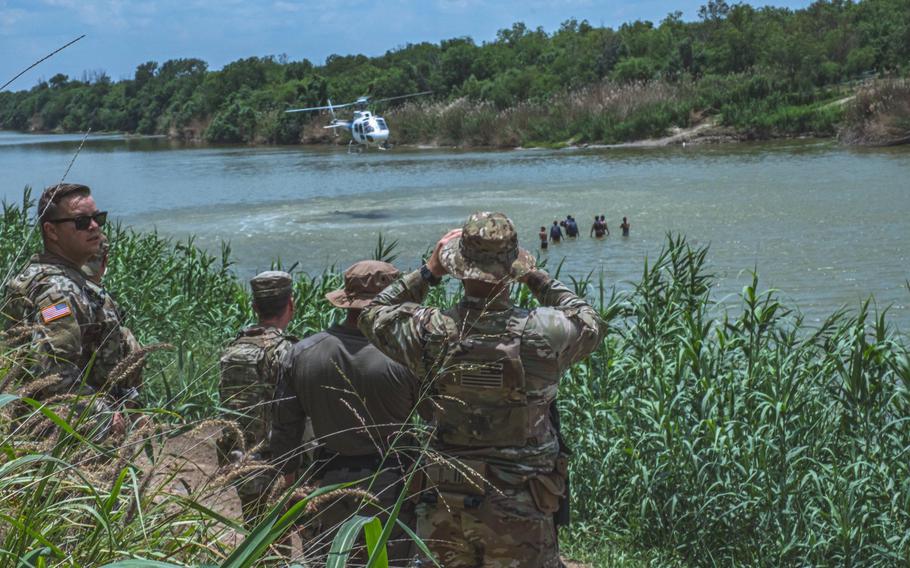
Soldiers from the Texas National Guard watch a Border Patrol helicopter hover above a group of civilians wading in the Rio Grande River along the Texas-Mexico border in 2023. More active-duty troops, resources and assets are on their way to the U.S. border with Mexico, White House officials said Wednesday, Jan. 22, 2025. (James Garcia/U.S. Army)
As many as 1,500 troops along with other resources and assets began moving to the U.S.-Mexico border on Wednesday for a deployment that includes the use of military aircraft to conduct deportation flights and support for construction efforts to extend the wall that separates the two countries, the Defense Department announced.
Acting Defense Secretary Robert Salesses approved three actions Wednesday, following executive orders signed Monday by President Donald Trump.
“The president directed me to take all appropriate action to support the activities of the secretary of Homeland Security in obtaining complete operational control of the southern border of the United States,” Salesses said in a statement.
The deportation flights will include more than 5,000 migrants detained by Customs and Border Protection near San Diego and El Paso, Texas, he said. The Department of Homeland Security will provide in-flight law enforcement and the State Department will obtain the necessary clearances and notification to other countries.
The deployment includes two C-17 and two C-130 transport aircraft to support the deportations, according to a senior military official who spoke to reporters Wednesday on the condition of anonymity.
Information on which troops or units will deploy or where they will go along the four-state border with Mexico was not announced, though White House Press Secretary Karoline Leavitt said Wednesday in an interview with Fox News that the “mission is underway.”
“This comes off [Trump’s] day one action … to direct the Defense Department to make homeland security a core mission of the agency,” she said. “This is something President Trump campaigned on. The American people have been waiting for such a time as this for our Defense Department to actually take homeland security seriously.”
Trump on Monday ordered the Pentagon to deploy as many troops as needed to the border. He also ordered the military to begin work on a wall between the U.S. and Mexico and come up with a security plan to “seal the border and maintain the sovereignty, territorial integrity and security” of the United States.
The deployment of 1,500 troops will include helicopters and intelligence analysts to support increased detection and monitoring, Salesses said. It will consist of 1,000 Army personnel, including a battalion headquarters, and 500 Marines, the senior military official said. The Marines were previously assigned to the Federal Emergency Management Agency to assist with the California wildfires.
“They were released from that mission [and] are being reassigned to the southwest border. These forces will work on the replacement of physical barriers and other border conditions,” the military official said.
The Marines and soldiers will join about 2,500 National Guard members now at the border, according to the Pentagon. Those troops work a support mission that includes detection and monitoring, data entry, training, transportation, vehicle maintenance, warehousing and logistical support. This includes helicopters for aerial reconnaissance in support of Customs and Border Protection personnel on the ground.
That mission began in April 2018 during Trump’s first term as president and remained in place during former President Joe Biden’s four years in office.
Trump deployed active-duty troops to the border for several months in late 2018 after a large group of migrants arrived at one time. Biden briefly returned active-duty forces to the mission in May 2023 to prepare for changes to border-security policies that were in place following the coronavirus pandemic.
U.S. Northern Command, which is the combatant command that has typically managed military troops working at the southwest border, will lead the mission with support from Transportation Command and the National Guard Bureau.
The military supported border wall construction during Trump’s first term as president, primarily through contract management. He also diverted more than $10 billion from the Defense Department, including money flagged for military construction projects, to build a wall along the border. When Biden took office in 2021, he halted most border wall construction.
Matthew Adams contributed to this report.